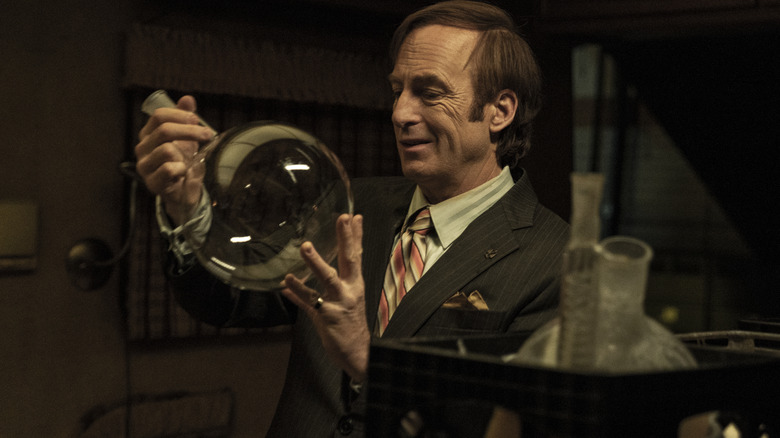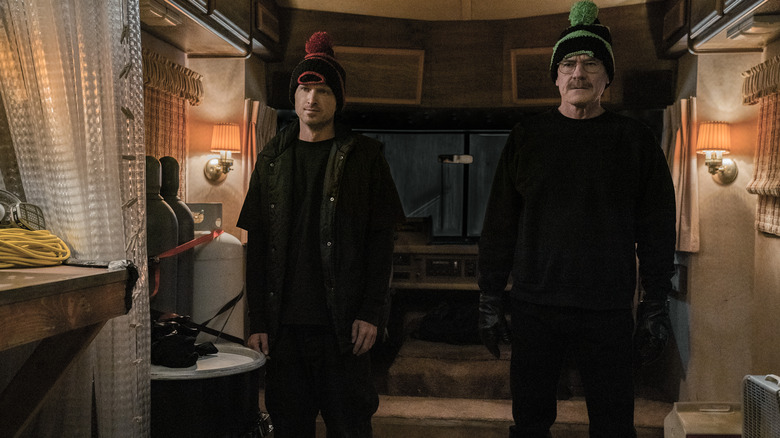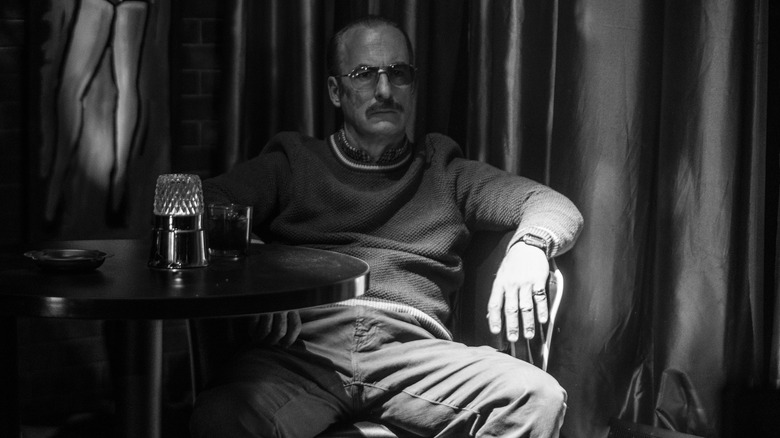Better Call Saul's Most Highly Anticipated Episode Reminds Us Why It's The Smartest Show On TV
Fans made sure to circle last night's episode of "Better Call Saul" on the calendar well in advance, especially after the title was first revealed and implicitly teased our long in-the-making returns of Bryan Cranston's Walter White and Aaron Paul's Jesse Pinkman, our "heroes" from "Breaking Bad." As promised, however, their appearances didn't unfold quite as expected. Rather than dedicating an entire episode set in a previously-unseen moment of the peak Heisenberg years, the latest episode charted its own course altogether – although only after a cold open set in that beloved, ramshackle Winnebago RV (excuse me, properly known as the "Crystal Ship") in one of Saul Goodman's (Bob Odenkirk) first and most memorable appearances.
In another bold move, one that rivals last week's inspired choice to fully immerse us in the black-and-white world of Gene Takovic, episode writer/director Thomas Schnauz brought us right back to that post-"Breaking Bad" timeline to check in with our favorite Cinnabon manager. You see, in quintessential "Better Call Saul" fashion, even the most fan-servicey hour yet served an important narrative purpose as we approach the final two episodes of the series. The end result was yet another brilliant episode in one of the show's best-ever stretches in its entire run.
Because "Better Call Saul" has always understood one crucial truth: It's more important to give viewers what we need rather than what we want ... even when we think we're getting what we want. More so than its ingenious protagonist with a penchant for flawlessly executed cons or the tightly-wound cartel plots that gave us some of the most tense moments in either series, that's the main reason why this series remains the smartest show on television as it rumbles towards its inevitable conclusion.
Fan service ... with a twist
Back in the early days of "Better Call Saul," it's clear that even the creators mistakenly assumed that the transformation from Slippin' Jimmy McGill to the immoral monster Saul Goodman would happen as soon as the end of the first season. This understandable instance of putting the cart before the horse felt prevalent even among the larger "Breaking Bad" fanbase at the time, many of whom weren't fully convinced of the wisdom behind this spin-off series in the first place. Sure, maybe there was some drama to mine out of the person who would eventually turn into the over-the-top criminal lawyer we all loved to hate ... but the quicker we get to the fun Saul stuff, the better — or so the conventional wisdom at the time would've had us believe.
Fast forward several years later, and the prolonged journey of Jimmy's downfall has packed far more tragedy and pathos than any of us could've anticipated. Jimmy's fractured relationship with disapproving brother Chuck (Michael McKean), his unexpectedly sweet and emotional romance with Kim Wexler (Rhea Seehorn), and the parallel journey of Jonathan Banks' Mike Ehrmantraut have all added up to a rich, compelling story of good intentions spiraling into something much darker and much deeper than the "Breaking Bad" origin story many of us assumed this would be.
By the time "Better Call Saul" finally brought Walt and Jesse into the proceedings, we should've known that this would prove far more interesting than merely a Marvel-like nostalgia tour. The specific way this episode used such familiar faces only further highlights why this series is ending on such a strong note.
It's all about Jimmy
Episode 11 of this sixth and final season will make headlines for the Walt and Jesse of it all, but its real magic comes from how purposefully the script juxtaposes Saul Goodman's obsession over the promising meth cooks with Gene Takovic's alarming insistence on his self-destructive cons — no matter the cost.
This final disgrace for Cinnabon Gene kicks off in earnest after a misguided phone call to the Florida workplace that Kim (still alive!) now resides. Frustratingly, we're not privy to whatever conversation upsets Gene so much, presumably robbing him of the reunion (or at least reconciliation) he so desperately wanted after Kim walked out on him. But driven by his same refusal to confront the pain that turned him into Saul in the first place, Gene embarks on multiple identity theft cons to reclaim some of that old Saul Goodman magic.
Throughout it all, however, we're treated to multiple edits where Saul's interactions with Walt and Jesse feed directly into Gene's ongoing crisis. That ominous grave dug out in the middle of the New Mexico desert neatly transitions into Gene in his bed, plotting his next move ... yet framed as if he were actually in that ditch and already dead. Later on, after Gene is so poisoned by that phone call (the creative team has promised we'll learn more about it in the final episodes, rest assured!), his choice to step out of the cab and cross the line into breaking and entering is paralleled by Saul Goodman stepping out of his car years earlier, defying Mike's warnings to stay away from troublemaking Walt and search him out instead.
Effectively, "Better Call Saul" used its most fan-servicey episode yet to further chart Jimmy/Saul/Gene's slow-motion free-fall. Even Saul would appreciate that sleight-of-hand trick.


